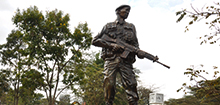
These are prepared using the Protected Areas Planning Framework (PAPF), which was developed and adopted by KWS management in 2006 as the Protected Area (PA) management planning standard. Prior to the PAPF, management plans developed for Kenya’s PAs were designed to fulfill a variety of often divergent functions, and as a result, the plans developed varied greatly in the issues they addressed and the information they provided. However, PAPF-based plans are primarily designed to be a practical management tool supporting PA managers in carrying out their duties. PAPF plans achieve this aim by providing strategic guidance on the goals towards which management is working, and a series of prescriptions and management actions that need to be implemented in order to achieve these aims. The following points summarize the key functions of a PAPF management plan:
- Vision: The plan sets out a common understanding between stakeholders and managers on the PA’s purpose and its exceptional resources, towards which all management action in the PA is focused.
- What: The plan establishes clear management objectives that are agreed upon by both stakeholders and managers and that, if achieved, will ensure the PA purpose will be fulfilled.
- How: The plan provides a rationale and clear, unambiguous guidance on the implementation of the specific management actions that managers will need to implement over the 10-year timeframe of the plan in order to achieve the management objectives.
- When and Who: The plan provides a series of detailed 3-year activity plans designed to turn the management plan into practical, timebound and realistic activities on the ground. The activity plans break down the implementation of each action into a series of discrete activities, and set out the timeframe for the implementation of each activity and who is responsible for its completion.
- Where: The plan includes a zonation scheme to enable different types and intensities of use in different parts of the area, and to help reconcile the sometimes competing conservation and development objectives.
- Rules: The plan sets out clear and unambiguous prescriptions on what can and cannot occur in different parts of the area (i.e. the different zones) in order to achieve the area’s management objectives and fulfill the area's purpose.
- Results: The plan provides a framework for monitoring both the impacts (positive and negative) resulting from plan implementation, and includes “milestones” for measuring the plan implementation itself.
DOWNLOAD: Protected Area Planning Framework - Planning Manual 2nd Edition September 2007





